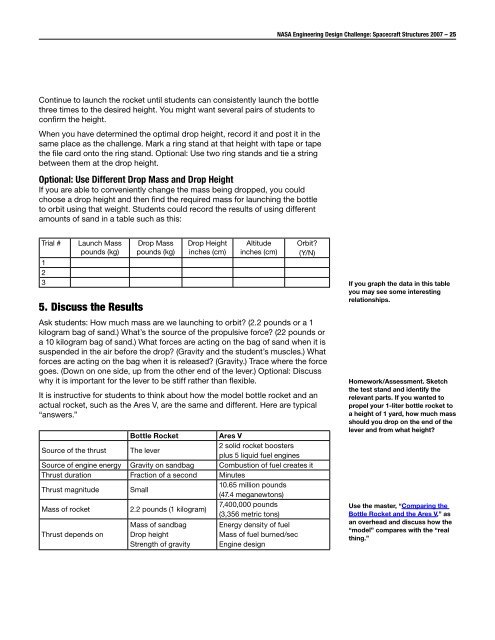Spacecraft Structures pdf - ER - NASA
Spacecraft Structures pdf - ER - NASA
Spacecraft Structures pdf - ER - NASA
- No tags were found...
You also want an ePaper? Increase the reach of your titles
YUMPU automatically turns print PDFs into web optimized ePapers that Google loves.
<strong>NASA</strong> Engineering Design Challenge: <strong>Spacecraft</strong> <strong>Structures</strong> 2007 – 25Continue to launch the rocket until students can consistently launch the bottlethree times to the desired height. You might want several pairs of students toconfirm the height.When you have determined the optimal drop height, record it and post it in thesame place as the challenge. Mark a ring stand at that height with tape or tapethe file card onto the ring stand. Optional: Use two ring stands and tie a stringbetween them at the drop height.Optional: Use Different Drop Mass and Drop HeightIf you are able to conveniently change the mass being dropped, you couldchoose a drop height and then find the required mass for launching the bottleto orbit using that weight. Students could record the results of using differentamounts of sand in a table such as this:Trial #123Launch Masspounds (kg)5. Discuss the ResultsDrop Masspounds (kg)Drop Heightinches (cm)Altitudeinches (cm)Orbit?(Y/N)Ask students: How much mass are we launching to orbit? (2.2 pounds or a 1kilogram bag of sand.) What’s the source of the propulsive force? (22 pounds ora 10 kilogram bag of sand.) What forces are acting on the bag of sand when it issuspended in the air before the drop? (Gravity and the student’s muscles.) Whatforces are acting on the bag when it is released? (Gravity.) Trace where the forcegoes. (Down on one side, up from the other end of the lever.) Optional: Discusswhy it is important for the lever to be stiff rather than flexible.It is instructive for students to think about how the model bottle rocket and anactual rocket, such as the Ares V, are the same and different. Here are typical“answers.”Bottle RocketAres VSource of the thrust The lever2 solid rocket boostersplus 5 liquid fuel enginesSource of engine energy Gravity on sandbag Combustion of fuel creates itThrust duration Fraction of a second MinutesThrust magnitude Small10.65 million pounds(47.4 meganewtons)Mass of rocket2.2 pounds (1 kilogram)7,400,000 pounds(3,356 metric tons)Thrust depends onMass of sandbagDrop heightStrength of gravityEnergy density of fuelMass of fuel burned/secEngine designIf you graph the data in this tableyou may see some interestingrelationships.Homework/Assessment. Sketchthe test stand and identify therelevant parts. If you wanted topropel your 1-liter bottle rocket toa height of 1 yard, how much massshould you drop on the end of thelever and from what height?Use the master, “Comparing theBottle Rocket and the Ares V,” asan overhead and discuss how the“model” compares with the “realthing.”
















